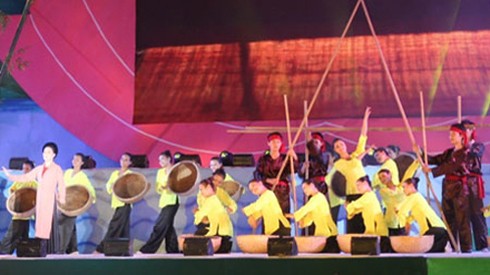(VOVworld)- Vi-giam singing is a type of traditional folk music practiced in the central provinces of Nghe An and Ha Tinh. Vi Giam folk tunes embrace the daily life of local people connecting people’s soul. The music genre has been handed through generations. It has recently been officially recognized by UNESCO as an intangible cultural heritage of humanity becoming Vietnam’s 9th internationally recognized heritage.
Vi-Giam singing is deeply imprinted in the minds of local people in Nghe An and Ha Tinh province. First originated from work activities, the lyrics and tunes of Vi Giam were simple depicting weaving and farming activities. Gradually these folk songs became more structured and enriched with more beautiful lyrics. Professor Tran Quang Hai, an expert on Vietnamese folk songs, lives in France. Hai says the beauty and value of Vi-Giam folk singing should be more widely known: “Folk tunes in Nghe An and Ha Tinh province are not widely known. Some folk tunes of the local weaving and conical hat making guilds are popular but few know about special characteristics of Vi-Giam folk singing. It is a type of duet singing with the lyrics reflecting people’s daily activities including weaving, making conical hats and harvesting rice. The verses are in the forms of six-eight word distich, seven-seven-six- eight word meter and allegoric. The tunes of Vi-Giam singing are the reflection of folk tunes of different Vietnamese folk music genres”.
Vi singing is a type of free singing in which the singers improvise. The pitches are low or high depends on the length of the verses and tunes. Unlike Vi singing, Giam tunes have clear tones and rhythms. The lyrics of Giam singing are sometimes narrative, humorous, satirical, and witty, and sometimes romantic. Vi and Giam are two different types of singing but they are performed together during farmers’ idle times or while they row a boat, fish, or collect wood in the forest or at festivals. Professor Tran Quang Hai said:“Vi-Giam singing has several rhythms but that echo typical rhythms of traditional Vietnamese music”.
Vi Giam singing persuaded the UNESCO Appraisal Committee of its vitality and popularity in being practiced in people’s activities- farming, weaving and lullabying. Marc Jacobs, a Belgian representative in 24-nation Inter-Governmental Committee of the 2003 Convention, commented on Vietnam’s Vi-Giam singing: “I highly appreciate the Vietnamese heritage. The documents cover special values of the heritage. It’s really an important and interesting document for research. Thank you Vietnam”.
 |
According to heritage experts, Vi-Giam singing has strong vitality and is a source of pride for Nghe An and Ha Tinh people. Its lyrics are simple and close to life, so it’s not a challenge to preserve and promote this music genre. Professor Nguyen Chi Ben is the former Director-General of the Vietnamese Culture and Arts Institute and a member of the Vietnam National Heritage Council: “Artists are the guardians of an intangible heritage. An artist is both audience and creator. We should distinguish between real artists and performers. In addition to oral transmission, it’s necessary to record and film Vi Giam singing to enable others to learn new singing techniques. But it’s also important to practice and perform this singing to promote its values”.
Professor Ben says that Vietnam should learn from other countries, including Japan, how to preserve intangible cultural heritages. It’s important to grant licenses and create venues where the artists can perform to enable them to earn a living by singing. That’s the only way, Ben says, that Vietnam can preserve this heritage intact.